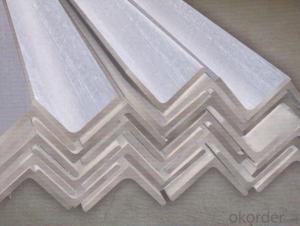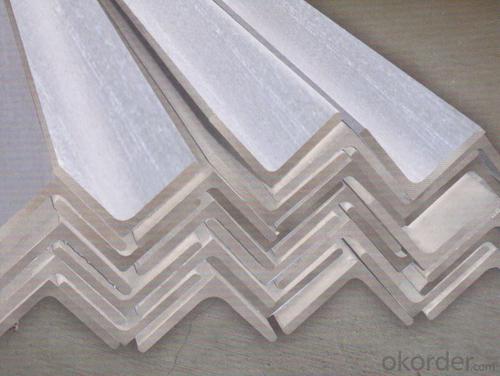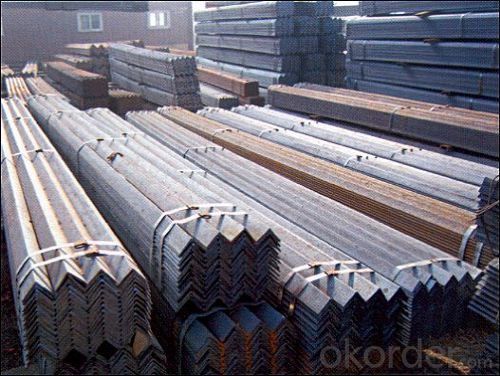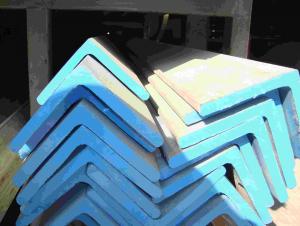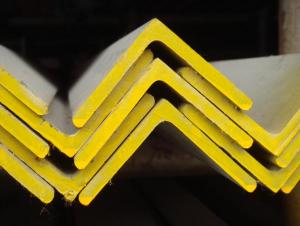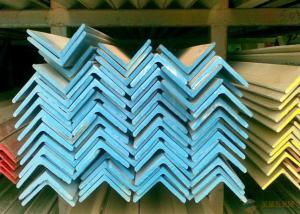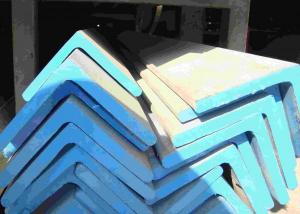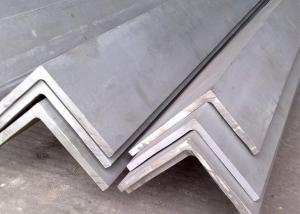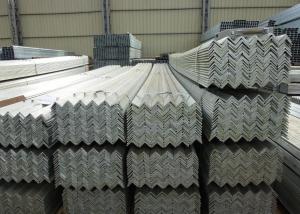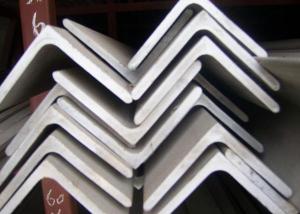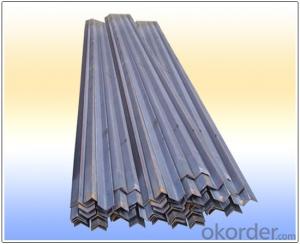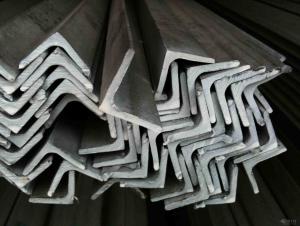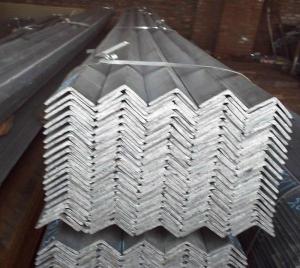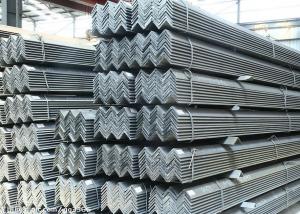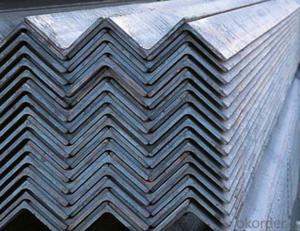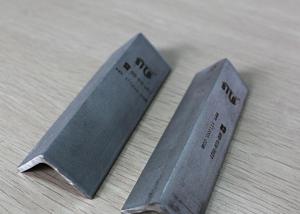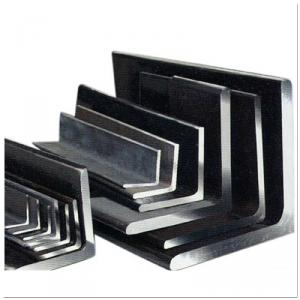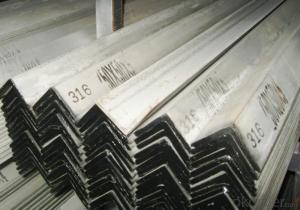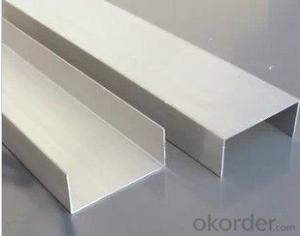Stainless Steel Angle
- Loading Port:
- China Main Port
- Payment Terms:
- TT OR LC
- Min Order Qty:
- -
- Supply Capability:
- -
OKorder Service Pledge
OKorder Financial Service
You Might Also Like
Specifications
Stainless Steel Angle Bar
Grade:304,316,316L,304L.430.
HRAP and sand blasting.
Size:2.5 x25x25mm--12 x120x120mm
Specifications
Item | Stainless Steel Angles |
Grade | 201 304 316 410 430 ect. |
Material | 200 300 400 500 600 SERIES |
Standard | GB, AISI, ASTM, ASME, EN, BS, DIN, JIS |
Surface | ordinary industrial surface, or customized |
Thickness | customized |
width | customized |
Length | 2000-6000mm, or customized |
Grade | Chemical Composition of our products (%) | |||||||||
C | Si | Mn | S | P | Cr | Ni | Cu | Mo | Fe | |
201 | 0.12 | 0.42 | 7.62 | 0.023 | 0.031 | 14.2 | 3.58 | 1.05 | / | balance |
304 | 0.053 | 0.41 | 1.22 | 0.018 | 0.036 | 18.15 | 8.04 | 0.048 | / | balance |
316 | 0.057 | 0.45 | 1.23 | 0.021 | 0.034 | 16.32 | 10.12 | 0.021 | 2.06 | balance |
410 | 0.14 | 0.41 | 0.43 | 0.023 | 0.031 | 11.83 | 0.004 | 0.002 | / | balance |
430 | 0.11 | 0.48 | 0.083 | 0.023 | 0.038 | 16.24 | 0.007 | / | / | balance |
We would be most appreciated if you could take your precious time to contact with us, also you can take this opportunity to feel our warm passion, even if you are not intended to purchase our products right now, we could make friends first.We would be most appreciated if you could take your precious time to contact with us, also you can take this opportunity to feel our warm passion, even if you are not intended to purchase our products right now, we could make friends first.
- Q: How does stainless steel angle perform in corrosive gases or fumes?
- Stainless steel angle performs exceptionally well in corrosive gases or fumes due to its high resistance to corrosion. The chromium content in stainless steel forms a protective layer, known as the passive film, which prevents the metal from reacting with the corrosive elements in the gases or fumes. This makes stainless steel angle highly suitable for applications in industries such as chemical processing, petrochemical, and marine environments where exposure to corrosive gases or fumes is prevalent.
- Q: Are stainless steel angles suitable for the production of bus shelters?
- Indeed, the utilization of stainless steel angles is appropriate for the fabrication of bus shelters. Given its exceptional durability and resistance to corrosion, stainless steel emerges as the perfect material for outdoor structures like bus shelters, which are constantly exposed to different weather conditions. By incorporating stainless steel angles, the structure gains both strength and stability, guaranteeing its long-lasting endurance against the elements. Moreover, stainless steel possesses an appealing and contemporary appearance, rendering it a favored option in architectural contexts, including bus shelters.
- Q: What are the environmental benefits of using stainless steel angle?
- Stainless steel angle offers several environmental benefits. Firstly, it is a highly durable material that is resistant to corrosion, reducing the need for frequent replacements and reducing waste. Additionally, stainless steel is 100% recyclable, making it an environmentally friendly choice. Its recyclability helps conserve natural resources and reduces the carbon footprint associated with manufacturing new materials. Moreover, stainless steel is hygienic and easy to clean, preventing the growth of bacteria and reducing the need for harsh chemicals. Overall, using stainless steel angle supports sustainability and contributes to a greener environment.
- Q: What are the electrical resistance properties of stainless steel angles?
- Stainless steel angles typically have relatively high electrical resistance properties due to their composition and crystalline structure, which allows them to resist the flow of electric current.
- Q: Can stainless steel angles be used in the production of chemical storage tanks?
- Yes, stainless steel angles can be used in the production of chemical storage tanks. Stainless steel is known for its excellent corrosion resistance, making it a suitable choice for storing various chemicals. The angles provide structural support and reinforcement in the tank's construction, ensuring its integrity and longevity.
- Q: Are stainless steel angles suitable for conveyor belts?
- Yes, stainless steel angles are suitable for conveyor belts. Stainless steel is known for its durability and resistance to corrosion, making it an excellent choice for conveyor belt systems. The angles provide structural support and stability to the belt, ensuring smooth and efficient operation. Additionally, stainless steel angles can withstand high temperatures, heavy loads, and harsh environments, making them ideal for various industries such as food processing, pharmaceuticals, and mining. Overall, stainless steel angles are a reliable and long-lasting option for conveyor belts.
- Q: How do stainless steel angles contribute to seismic resistance?
- Stainless steel angles are versatile structural components that play a crucial role in enhancing the seismic resistance of buildings and structures. They contribute to seismic resistance in several ways. Firstly, stainless steel angles are known for their high strength and ductility, which allows them to withstand the dynamic forces generated during an earthquake. Their exceptional mechanical properties enable them to resist bending, twisting, and shearing forces, providing structural stability and integrity to the building. Moreover, stainless steel angles offer excellent corrosion resistance, which is a significant advantage in seismic regions prone to high levels of moisture and humidity. By maintaining their structural integrity over time, stainless steel angles ensure the long-term stability and performance of the building during seismic events. Additionally, stainless steel angles can be easily welded and fabricated, allowing for efficient construction processes. This versatility enables engineers to design and construct seismic-resistant systems more effectively, incorporating features such as moment-resisting frames, braced frames, or other seismic-resistant structural systems. Furthermore, stainless steel angles have a high fire resistance, which is another critical factor in seismic design. In the event of a seismic event followed by a fire, stainless steel angles can withstand high temperatures for more extended periods without losing their structural strength. This characteristic ensures that the building remains stable and safe for occupants and emergency responders. Lastly, stainless steel angles provide several design opportunities due to their aesthetic appeal and architectural versatility. Architects and designers can incorporate stainless steel angles into the building's overall design, creating visually appealing structures that also meet the required seismic resistance standards. In conclusion, stainless steel angles contribute to seismic resistance by providing high strength, ductility, corrosion resistance, fire resistance, and design flexibility. These properties allow them to withstand the dynamic forces generated during an earthquake, ensuring the structural stability and integrity of buildings in seismic regions.
- Q: What are the different surface treatments for stainless steel angles?
- There are several different surface treatments that can be applied to stainless steel angles to enhance their appearance, durability, and corrosion resistance. Some of the most common surface treatments for stainless steel angles include: 1. Mill Finish: This is the standard finish that is achieved through the manufacturing process. It has a smooth, polished appearance but may still have some minor imperfections. 2. Brushed Finish: Also known as satin finish, this treatment involves brushing the surface of the stainless steel angle with a fine abrasive material. It creates a textured, linear pattern that hides scratches and gives a matte appearance. 3. Mirror Finish: This treatment involves polishing the stainless steel angle to a high gloss finish, resembling a mirror. It requires more extensive polishing and buffing to achieve a reflective surface. 4. Bead Blasted Finish: In this treatment, small glass beads are blasted onto the surface of the stainless steel angle to create a uniform, matte texture. It provides a consistent finish and hides fingerprints and scratches. 5. Powder Coating: This is a popular surface treatment method where a dry powder is electrostatically applied to the stainless steel angle and then cured under heat. It provides a durable, colorful, and resistant coating that can withstand harsh environments. 6. Passivation: This treatment involves immersing the stainless steel angle in an acid bath to remove any impurities and contaminants from the surface. It improves the corrosion resistance and restores the stainless steel's passive state. 7. PVD Coating: Physical Vapor Deposition (PVD) is a process that involves depositing a thin film of metal onto the stainless steel angle through vaporization. This treatment provides a range of decorative and durable finishes like gold, black, or bronze. These different surface treatments for stainless steel angles offer a variety of options to meet specific aesthetic and functional requirements. The choice of treatment depends on factors such as the intended use, desired appearance, and environmental conditions.
- Q: Can stainless steel angle be used in cryogenic applications?
- Yes, stainless steel angle can be used in cryogenic applications. Stainless steel is known for its excellent corrosion resistance and high strength at low temperatures, which makes it a suitable material for cryogenic environments. Stainless steel angles can withstand the extreme cold temperatures and maintain their structural integrity, making them ideal for applications such as cryogenic storage tanks, pipelines, and equipment used in the production and transportation of liquefied gases. Additionally, stainless steel's resistance to thermal expansion and contraction helps to ensure dimensional stability in cryogenic systems.
- Q: What grades of stainless steel are used for angles?
- The grades of stainless steel commonly used for angles are 304/304L and 316/316L.
Send your message to us
Stainless Steel Angle
- Loading Port:
- China Main Port
- Payment Terms:
- TT OR LC
- Min Order Qty:
- -
- Supply Capability:
- -
OKorder Service Pledge
OKorder Financial Service
Similar products
Hot products
Hot Searches
Related keywords
